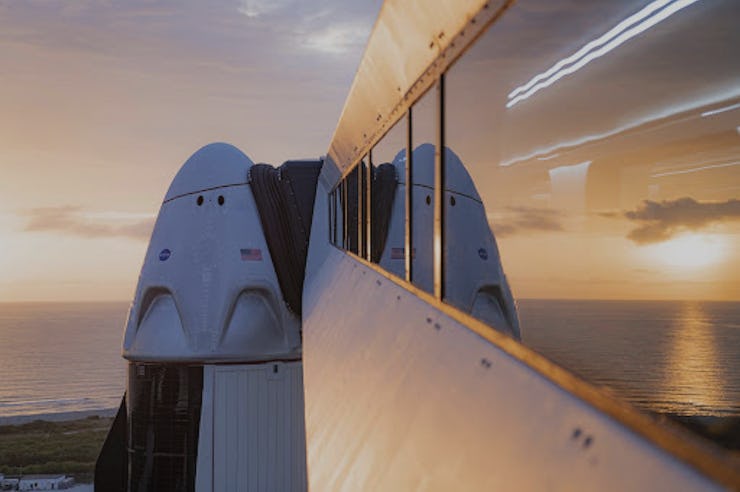Ex-SpaceX manager says Inspiration4 is just the start
A former Crew Dragon project manager explains how it charts the future.

Falcon 9 rockets turned into a symbol of modern spaceflight after SpaceX’s first successful booster landing just six years ago.
Since then, SpaceX has transported things like baby squid, satellites, and people with their Cargo and Crew Dragon capsules, which use Falcon 9 boosters to burst off into space. These capsules wouldn’t be possible without people like SpaceX senior advisor Garrett Reisman, who once helped develop Crew Dragon.
Now, Reisman’s groundbreaking project is about to power the first all-civilian mission to space — but that’s just the start.
A story for the space-ages
The former NASA astronaut flew on three space shuttles across two visits to the ISS, one in 2008 (where Reisman arrived and returned on different shuttles) and one in 2010. In 2011, when the shuttle program ended, SpaceX hired him and assigned him to the nascent Crew Dragon project.
The project was pivotal in replacing the shuttle. After the shuttle program ended, NASA rented seats on Soyuz rockets taking off from Kazakhstan to send its astronauts to the International Space Station — the agency had to pay around $80 million per seat and send its astronauts halfway around the world. The Crew Dragon, developed as part of NASA’s Commercial Crew program, would bring these flights back to the United States and bring costs closer to $55 million per seat.
“Back when I first started at SpaceX, I remember having lots of meetings with NASA as we talked about the Commercial Crew program about, hey, we can use these vehicles for other missions,” Reisman tells Inverse. “Not just for NASA astronauts, but private citizens.”
Reisman says that non-NASA missions like Inspiration4 were “part of the whole impetus” behind the Commercial Crew program. These missions would help “defray the costs,” but a lot of people “doubted whether it would actually happen.”
With next week’s launch, those doubts are history.
Want to know more about Crew Dragon’s inception, SpaceX’s surprising spacesuits, and why failure was “not an option” for the Elon Musk-led company? Read the full interview with Garrett Reisman, only in MUSK READS+.
Elon Musk’s vision shakes out
Reisman says he “inherited Elon’s vision” with the Crew Dragon project. It’s part of the overall goal of making humans a multi-planetary species.
- The cargo Dragon first sent NASA supplies to the ISS in 2012. The first capsule had windows “to make a statement…[SpaceX CEO Elon Musk] didn't create the company to send toothpaste and snacks to space, [it was] to send humans into space.”
- The Crew Dragon, built on the cargo-carrying Dragon, first sent astronauts to the ISS in May 2020. The capsule was designed to enable “a commercial infrastructure where people would pay for passage for people and cargo.”
- The under-development Starship, which builds on the Dragon capsules, will send around 100 people to space at a time.
- Reisman says this enables a city on Mars, which requires “hundreds of thousands of people.”
Musk has an ambitious goal to building a self-sustaining city on the planet by 2050. It’s a gargantuan task that will require thousands of Starship trips, transporting around one million tons at the cost of anywhere between $100 billion and $10 trillion.
Inspiration4 will fly just four people, but it could help pave the way to establishing a multi-planetary species.
TO READ THE FULL INTERVIEW, SUBSCRIBE TO MUSK READS+.
Here is what you will gain from subscribing to MUSK READS+:
- Three emails per week, enabling fans to go deeper into the week’s news.
- Original interviews and reporting, longform analysis, previews, and recaps of major events, including earnings calls and more.
- Community-focused extras like responses to reader mail, an upcoming event calendar, and notable anniversaries.
- An archive of previous subscriber-only content, so you can easily read back over what you might have missed.
- Promotional deals and offers.
- Supporting original, independent journalism.
MUSK READS+ is a fully independent operation. We are not Elon Musk, nor are we employed by him. Our job is to report the events we find newsworthy, giving you the inside look at the worlds of space rockets, electric cars, clean energy, and more. It means first-hand accounts of a SpaceX rocket launch, Tesla insights from third-party analysts, and more.
If you want to support us in our mission, and receive original interviews and analysis, consider contributing with a subscription.
This article was originally published on